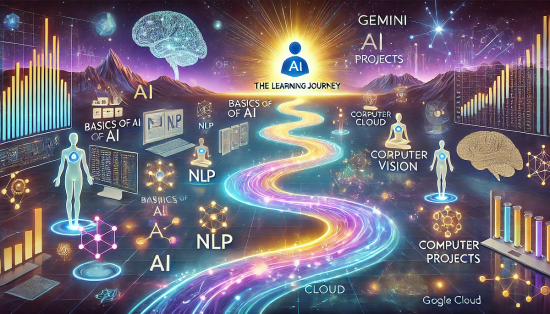Gemini AI, Google’s groundbreaking multimodal AI platform, is transforming the way we think about and use artificial intelligence. If you’re curious about how to start your Gemini AI journey but feel overwhelmed, don’t worry — I’ve got you covered.
Let’s walk through a simple, interactive roadmap that makes learning Gemini AI not just achievable but exciting!
Step 1: Build Your Foundation in AI
Think of this as learning the ABCs before diving into novels. Here’s where to start:
- Learn Python: AI runs on Python! Get comfortable with libraries like NumPy (for numbers), pandas (for data), and Matplotlib (for visuals).
- Understand AI Basics:
What’s supervised learning? Think of it as training a model to recognize patterns (like teaching a child to recognize animals).
What’s unsupervised learning? This is more like grouping similar things together without instructions (like sorting puzzle pieces).
- Experiment with Frameworks: Start with TensorFlow or scikit-learn to get hands-on practice.
💡 Tip: Use free resources like Kaggle or Google Colab to experiment with code without installing anything.
Step 2: Understand Multimodal AI
Gemini AI can handle text, images, and even combine them — that’s what makes it special! Let’s break it down:
Text (NLP):
- Start with tasks like text summarization or question answering.
- Play around with popular models like BERT or GPT to see how AI processes language.
Images (Computer Vision):
- Learn how AI detects objects or recognizes faces using tools like OpenCV or TensorFlow.
💡 Challenge: Combine text and image tasks. For example, create a tool that describes an image in text.
Step 3: Meet Gemini AI
Now that you have a foundation, it’s time to explore Gemini AI. Think of it as stepping into a high-tech lab where creativity meets innovation.
- Start with Documentation: Google’s Gemini AI docs are your treasure map. Explore what it can do, like generating images from text or understanding complex questions.
- Explore Google Cloud Tools: Gemini AI is part of Google Cloud’s ecosystem. Familiarize yourself with Vertex AI — it’s where the magic happens.
💡 Try It Out: Create a free Google Cloud account and experiment with sample datasets.
Step 4: Build Your First Gemini AI Projects
Ready to roll up your sleeves? Start simple, then go big:
Beginner Ideas:
- A chatbot that generates both text and images.
- A tool that summarizes articles and adds relevant visuals.
Advanced Challenges:
- Use Gemini’s Retrieval-Augmented Generation (RAG) capabilities to fetch and process real-time data.
- Develop a multi-agent AI system where one AI handles text, another handles visuals, and they collaborate to solve problems.
💡 Pro Tip: Start small and focus on one feature at a time. Each project builds your confidence.
Step 5: Dive Into Advanced Gemini Features
Once you’re comfortable, it’s time to go deeper:
- Fine-Tuning: Train Gemini AI with your data to make it industry-specific.
- Combine with APIs and Databases: Imagine building a smart assistant that fetches live data (e.g., weather updates) and explains it visually.
💡 Hackathon Idea: Build a personalized travel planner using Gemini AI to generate itineraries and visuals for each location.
Step 6: Deploy and Share Your Work
Creating projects is great, but sharing them takes your learning to the next level.
- Build User Interfaces: Use tools like Streamlit or Flask to make your AI tools easy to use.
- Host on Google Cloud: Deploy your project for the world to see.
💡 Quick Win: Share your projects on GitHub or Medium to get feedback and showcase your skills.
Step 7: Stay Updated and Keep Experimenting
AI moves fast, and so should you:
- Follow Google’s Announcements: Gemini AI is constantly evolving, so keep an eye on new features.
- Join Communities: Google Developer Groups (GDG) and hackathons are great for networking and learning.
- Build Continuously: Make it a habit to experiment with new ideas and tools.
💡 Fun Activity: Join a GDG meetup or a hackathon — it’s a fantastic way to learn and network.
Your Turn to Shine!
Gemini AI opens doors to endless possibilities, whether you’re building smarter chatbots, innovative tools, or just exploring the cutting edge of AI. Remember, the key is to start small, stay curious, and keep experimenting.
So, are you ready to dive into the world of Gemini AI? Let me know in the comments what you’re planning to build, and let’s innovate together!

If you found this roadmap helpful, share it with others who might be curious about Gemini AI. Let’s grow and learn as a community!
Your Step-by-Step Guide to Learning Gemini AI: The Future of AI, Simplified was originally published in Google Developer Experts on Medium, where people are continuing the conversation by highlighting and responding to this story.






